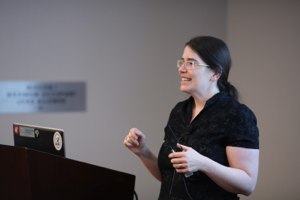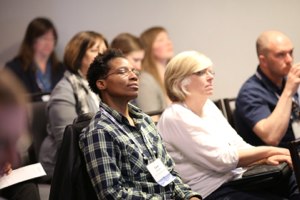As an undergraduate engineering student Karen Sandler was used to being the only woman in a class. At the time she didn’t want to talk about why there weren’t more women in technology, though, believing the attention would only make things worse. That attitude has changed over time, however, as she experienced sexism more directly. At tech conferences, for example, her male colleagues would sometimes ask her whose spouse she was, not knowing that she was actually a speaker at the event.
 Now as a FOSS attorney and the executive director of the GNOME Foundation, Sandler is taking a different approach by addressing sexism head-on.
Now as a FOSS attorney and the executive director of the GNOME Foundation, Sandler is taking a different approach by addressing sexism head-on.
“In our space it’s a real problem. We don’t have that many women,” Sandler said in her presentation Wednesday at The Linux Foundation Collaboration Summit in San Francisco. “People who haven’t experienced it directly aren’t aware of how bad it can get. There’s a lot of subtle sexism.”
Programs for Women
The software industry needs a culture change that can best come about by bringing more women to the profession, she said, especially into the free and open source software community. Currently 25 percent of all software developers are women, but only 3 percent work in free and open source software.
“It’s an amazing gulf,” Sandler said.
The good news is that attracting women to open source can be accomplished through intentional outreach. GNOME’s Outreach Program for Women (OPW), an internship designed to welcome and mentor women to the community, has already helped increase diversity for the GNOME project as well as the 10 other open source projects involved.
 Since OPW began a few years ago, the number of women applying accepted to work with GNOME in the Google Summer of Code program, for example, has risen from one in 2006, to seven in 2011, and five in 2012. And women attending the GNOME conference GUADEC increased to 17 percent in 2012, from 4 percent in 2009.
Since OPW began a few years ago, the number of women applying accepted to work with GNOME in the Google Summer of Code program, for example, has risen from one in 2006, to seven in 2011, and five in 2012. And women attending the GNOME conference GUADEC increased to 17 percent in 2012, from 4 percent in 2009.
The key to the program’s success, Sandler said, was to think about exactly why women weren’t participating and address each concern systematically.
“When we specifically target women, they’re much more likely to apply,” Sandler said. “Many have told me they never thought they could have an internship like this” and wouldn’t have applied without an invitation.
Here are Sandler’s 5 tips for bringing women into a project. She also offered more advice on what to include in an internship and how to follow up with mentors and alumni afterward. For more, watch the video of her presentation, below.
5 tips for Bringing More Women into Open Source
1. Address women directly.
2. Accept non-students and non-coders.
3. Connect women with mentors. “There’s a feeling that women are less likely to ask for help, and find a mailing list intimidating… Mentors respond to newcomers and make them feel welcome,” Sandler said.
4. Require a contribution as part of the application. It can be small like fixing a minor bug or rewording a pagraph of documentation. It gives people a head start for joining the community and also gives program administrators a better idea of who is applying and whether they’re good.
5. Make sure women don’t feel pressure to propose really ambitious projects.
Interested in a FOSS internship for women? May 1 is the application deadline for the next OPW.


